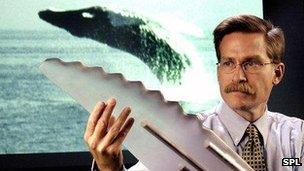Nature-inspired materials could help camouflage
- Published
Scientists at the University of Bristol develop artificial muscles that mimic the camouflaging ability of squids
Smart clothes that change colour could help people to camouflage - just like squid and zebrafish do, say scientists.
A team at the University of Bristol has developed artificial muscles that mimic the colour-changing ability of squid.
The technology falls into the category of soft robotics - a domain that blends together organic chemistry, soft materials science, and robotics.
The study appears in the journal Bioinspiration and Biomimetics.
Soft robots
The University of Bristol team decided to combine biomimicry - technology that imitates nature - and robotics.
"We study and mimic the characteristics of biological organisms to create soft robots and soft devices," says Dr Rossiter.
"Where conventional robots are rigid and inflexible, we focus instead on the soft structures that nature is so good at making.
"These include artificial muscles."
To create the artificial muscles, the researchers studied how certain animals changed colour.
They do it for various reasons - in case of danger, or depending their mood, stress level, changes in outside temperature, when communicating or attracting a mate.
Cephalopods - squid, cuttlefish and octopuses - change colour by using tiny muscles in their skins to stretch out small sacs of black colouration.
These sacs are located in the animal's skin cells, and when a cell is ready to change colour, the brain sends a signal to the muscles and they contract.
This makes the sacs expand and creates the optical effect which makes the animal look like it is changing colour.

Researchers mimic humpback whales' flippers to build turbine blades
The scientists also noted that zebrafish had a different camouflaging ability - by pumping black pigmented fluid from under the skin to the surface of the skin.
Smart materials
To mimic these natural mechanisms, the team used "smart" electro-active polymeric materials, connected to an electric circuit.
When a voltage was applied, the materials contracted; they returned to their original shape when they were short-circuited.
"These artificial muscles can replicate the [natural] muscular action… and can have strong visual effects," said Dr Rossiter.
"These materials, and this approach, is ideal for making smart colour-changing skins or soft devices in which fluid is pumped from one place to another.
"This could help us create a whole host of new technologies, ranging from active-camouflage and clothes that change colour and pattern, to a smart second-skin that can cool you when you are hot and keep you warm when you are cold."
There have been previous attempts by other scientists to create artificial camouflage, said a senior research scientist at Nasa's Jet Propulsion Laboratory Dr Yoseph Bar-Cohen - for example, by using "liquid crystals to change colors of surfaces by changing the temperature".
"But I am not aware of similar accomplishment using artificial muscles like the one reported in this paper," he said, adding however that much more "still needs to be done to advance the level of readiness of this technology to the point that we can expect to see a commercial product".
Nature-inspired designs
People have been looking at nature's solutions to our world's problems for centuries.
This copycatting gave birth to a science called biomimicry, also known as biometrics.
<link> <caption>The term "biomimicry"</caption> <altText>Biomimicry</altText> <url href="http://www.bbc.co.uk/news/business-15480620" platform="highweb"/> </link> was coined in 1998 by a natural history writer Janine Benyus.
"It is important to look at nature - after all, it has had 3.8 billion years to come up with ideas," she told the BBC last October.
In 2005, Ms Benyus set up the world's first Biomimicry Institute, with the main goal to help businesses develop nature-inspired designs.
- Published28 October 2011